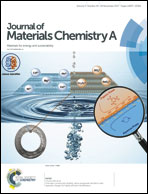Sustainable polymeric material for the facile and repetitive removal of oil-spills through the complementary use of both selective-absorption and active-filtration processes†
Abstract
Oil contamination in aqueous phases by regular industrial discharges and accidental oil spillages during the production and transportation of oil is emerging as a global challenge due to its catastrophic effect on the aquatic ecosystem. Here, a naturally abundant fibrous substrate (i.e., a cotton ball) is strategically exploited in the energy-efficient and environmentally-friendly cleaning of different forms of oil-contamination, including floating light-oil, and sedimentary heavy-oil and emulsions, after the appropriate optimization of both the topography and the essential chemistry of the fibrous substrate through a catalyst-free, simple and scalable 1,4-conjugate addition reaction between amine and acrylate groups under ambient conditions. The synthesized superhydrophobic cotton (SHC), that is capable of extreme repellence of water both in air and under oil, has provided a single avenue for both highly selective (1) absorption (with an efficiency above 2000 wt% for both heavy and light oils) and (2) gravity-driven active filtration of oil. The synthesized material is highly efficient in the separation of oil from aqueous phases that are chemically harsh, including extremes of pH (1 & 12), artificial seawater, etc. The embedded superhydrophobicity in the synthesized material remained unperturbed, even after prolonged (10 days) exposure to UV irradiation (both at 254 nm and 365 nm) and after incurring various physical deformations. Although this synthesized material was repeatedly (100 times) used in removing oil contamination, the antifouling property remained intact with an advancing water contact angle of 157° and the oil/water separation efficiency remained around 95%. Further, the current approach provided a simple basis to separate oil from a complex three-phase oil/water mixture that was composed of a heavy-oil phase (the bottom layer), an aqueous phase (the middle layer), and a light-oil phase (the top layer), where the strategic application of SHC allowed the successful clean-up of oils through the complementary use of absorption and filtration processes.



 Please wait while we load your content...
Please wait while we load your content...